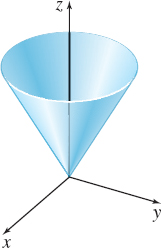15.8 Assess Your Understanding
Concepts and Vocabulary
Question
True or False The divergence of a vector field \(\mathbf{ F}\) is a vector.
Question
If \(\mathbf{F} (x,y,z)=P(x,y,z) \mathbf{i}+ Q(x,y,z)\mathbf{j}+R(x,y,z)\mathbf{k}\) is a vector field, where \(\dfrac{\partial P}{\partial x}\), \(\dfrac{\partial Q}{ \partial y}\), and \(\dfrac{\partial R}{\partial z}\) each exist, then \(\rm{ div}\mathbf{F}=\)__________.
Skill Building
In Problems 3–8, find the divergence of \(\mathbf{F}\).
Question
\(\mathbf{F}(x,y,z)=x^{2}\mathbf{i}+y^{2}\mathbf{j}+z^{2}\mathbf{k}\)
Question
\(\mathbf{F}(x,y,z)=x\mathbf{i}+xy\mathbf{j}+xyz\mathbf{k}\)
Question
\(\mathbf{F}(x,y,z)=(x+\cos x)\mathbf{i}+(y+y\sin x)\mathbf{j}+2z\mathbf{k}\)
Question
\(\mathbf{F}(x,y,z)=xye^{z}\mathbf{i}+x^{2}e^{z}\mathbf{j}+x^{2}ye^{z}\mathbf{k}\)
Question
\(\mathbf{F}(x,y,z)= \sqrt{x^2+y^2} \mathbf{i}+ \sqrt{x^2+y^2} \mathbf{j} +z\mathbf{k} \)
Question
\(\mathbf{F}(x,y,z) = xy^2 \mathbf{i} + x^2y \mathbf{j} + xyz{\bf k}\)
In Problems 9–18, use the Divergence Theorem to find \(\iint\limits_S \mathbf{F}\,{\bf\cdot}\, \mathbf{n}\,dS\), where \(\mathbf{n}\) is the outer unit normal vector to \(S\).
Question
\(\mathbf{F}=(2xy+2z)\mathbf{i}+(y^{2}+1)\mathbf{j} -(x+y)\mathbf{k}\); \(S\) is the surface of the solid enclosed by \(x+y+z=4\), \(x=0\), \(y=0\), and \(z=0\).
Question
\(\mathbf{F}=(2xy+z)\mathbf{i}+y^{2}\mathbf{j}-(x+4y)\mathbf{k}\) ; \(S\) is the surface of the solid enclosed by \(2x+2y+z=6\), \(x=0\), \(y=0\), and \(z=0\).
Question
\(\mathbf{F}=x^{2}\mathbf{i}+y^{2}\mathbf{j}+z^{2}\mathbf{k}\); \(S\) is the surface of the solid enclosed by \(x=0\), \(x=1\), \(y=0\), \(y=1\), \(z=0\) , and \(z=1\).
Question
\(\mathbf{F}=(x-y)\mathbf{i}+(y-z)\mathbf{j}+(x-y)\mathbf{k}\); \( S\) is the surface of the solid cube with its center at the origin and faces in the planes \(x=\pm 1\), \(y=\pm 1\), and \(z=\pm 1\).
Question
\(\mathbf{F}=x^{2}\mathbf{i}+2y\mathbf{j}+4z^{2} \mathbf{k}\); \(S\) is the surface of the solid cylinder \(x^{2}+y^{2}\leq 4\), \(0\leq z\leq 2\).
Question
\(\mathbf{F}=x\mathbf{i}+2y^{2}\mathbf{j}+3z^{2}\mathbf{k}\); \(S \) is the surface of the solid cylinder \(x^{2}+y^{2}\leq 9\), \(0\leq z\leq 1\).
Question
\(\mathbf{F}=x\mathbf{i}+y\mathbf{j}+z\mathbf{k}\); \(S \) is the sphere \(x^{2}+y^{2}+z^{2}=1\).
Question
\(\mathbf{F}=2x\mathbf{i}+2y\mathbf{j}+2z\mathbf{k}\); \(S\) is the sphere \(x^{2}+y^{2}+z^{2}=2\).
Question
\(\mathbf{F}=(x+\cos x)\mathbf{i}+(y+y\sin x)\mathbf{j}+2z \mathbf{k}\); \(S\) is the surface of the solid enclosed by the tetrahedron with vertices \((0,0,0),(1,0,0),(0,1,0)\), and \((0,0,1)\).
Question
\(\mathbf{F}=yz\mathbf{i}+xz\mathbf{j}+xy\mathbf{k}\); \(S\) is the surface of the solid enclosed by the tetrahedron with vertices \((0,0,0),(1,0,0),(0,1,0)\), and \((0,0,1)\).
Applications and Extensions
Question
Volume Let \(\mathbf{F}=x\mathbf{i}+y\mathbf{j}+z\mathbf{k}\); let \(S\) be the surface of a solid \(E \) satisfying the Divergence Theorem; and let \(\mathbf{n}\) be the outer unit normal vector to \(S\). Show that the volume \(V\) of \(E \) is given by the formula \(V=\dfrac{1}{3}\iint\limits_{S} \mathbf{F}\,{\bf\cdot}\, \mathbf{n}\,dS\).
1045
Volume In Problems 20–22, use the formula given in Problem 19 to find each volume.
Question
A rectangular parallelepiped with sides of length \(a,b\), and \(c\)
Question
A right circular cone with height \(h\) and base radius \(R\)
(Hint: The calculation is simplified with the cone oriented as shown in the figure.)

Question
A sphere of radius \(R\)
In Problems 23 and 24, find \(\iint\limits_S \mathbf{F}\,{\bf\cdot}\, \mathbf{n}\,dS\) and \(\iiint\limits_{E}{\rm{div}}\,\mathbf{F}\, dV\) separately and verify the Divergence Theorem.
Question
\( \mathbf{F}(x,y,z)=x\mathbf{i}+y\mathbf{j}+z\mathbf{k}\); \(S\) is the surface of the sphere \(x^{2}+y^{2}+z^{2}=100.\)
Question
\( \mathbf{F}(x,y,z)=x\mathbf{i}+y\mathbf{j}+z\mathbf{k}\); \(S\) is the closed cylindrical surface \(x^{2}+y^{2}=1\) between \(z=0\) and \(z=2.\)
Question
Show that if \(\mathbf{F}\) is a constant vector field and \(S\) is the surface of a solid \(E \) satisfying the assumptions of the Divergence Theorem, then \(\iint\limits_S \mathbf{F}\,{\bf\cdot}\, \mathbf{n}\,dS=0\).
Question
Let \(\mathbf{F}=3x\mathbf{i}+4y\mathbf{j}+(7z+2x)\mathbf{k}\) and \(\mathbf{G}=2x\mathbf{i}+3y\mathbf{j}+(9z+6y)\mathbf{k}\). Let \(S\) be the surface of a solid \(E \) satisfying the assumptions of the Divergence Theorem. Show that \(\iint\limits_S \mathbf{F}\,{\bf\cdot}\, \mathbf{n} \,dS=\iint\limits_S \mathbf{G}\,{\bf\cdot}\, \mathbf{n}\,dS\).
Question
Flux Suppose the velocity of a fluid flow in space is constant.
- Show that the flux through any closed surface is \(0\).
- In your own words, give a physical interpretation of (a).
Question
Let \(\mathbf{F}(x,y,z)=\dfrac{1}{\rho }(x\mathbf{i}+y\mathbf{j}+ z\mathbf{k})\), where \(\rho =\sqrt{x^{2}+y^{2}+z^{2}}\). Show that \({\rm{div}} \mathbf{F}=\dfrac{2}{\rho }\).
Question
- Use Problem 28 and the Divergence Theorem to find \[ \iiint\limits_E \dfrac{dV}{\sqrt{x^{2}+y^{2}+z^{2}}} \] where \(E \) is the solid inside the sphere \(x^{2}+y^{2}+z^{2}=1\).
- Verify the solution to (a) by finding the triple integral directly.
Question
Assume that the hypotheses of the Divergence Theorem hold for \(S\) and \(E.\) Show that if \(f\) satisfies the Laplace equation \((f_{xx}+f_{yy}+f_{zz}=0)\) in a closed, bounded solid \(E \) with boundary \(S\) with outer unit normal \(\mathbf{n}\), then \(\iint\limits_S {\bf \nabla} f\,{\bf\cdot}\, \mathbf{n}\,dS=0\).
Challenge Problems
Question
Let \(\mathbf{F}=x^{2}\mathbf{i}+y^{2}\mathbf{j}+z^{2}\mathbf{k}\) and let \(\mathbf{n}\) be the outer unit normal to the surface \(S\). Use the Divergence Theorem to show that \[ \iint\limits_{S}\mathbf{F}\,{\bf\cdot}\, \mathbf{n}\,dS=\dfrac{8\pi q^{4}}{3} \]
if \(S\) is the surface \(x^{2}+y^{2}+z^{2}=2qz\), \(q>0\).
Question
What is the value of the integral in Problem 31 if \(S\) is the surface of the cube \(x=0\), \(x=q\), \(y=0\), \(y=q\), \(z=0\), and \(z=q\), \(q>0\)?
Question
Let \(f\) and \(g\) be two scalar functions and let \(S\) be the surface of a solid \(E \) satisfying the assumptions of the Divergence Theorem. Show that \[ \iint\limits_{S}f( {\bf\nabla}g) \,{\bf\cdot}\, \mathbf{n\,} dS=\iiint\limits_E[ f( {\bf\nabla}^{2}g) + {\bf\nabla}\! f\,{\bf\cdot}\, {\bf\nabla}g] \,dV \]
[Hint: Let \(\mathbf{F}=f( {\bf\nabla }g) \) in the Divergence Theorem and use \({\bf\nabla}^{2}g={\bf\nabla} \,{\bf\cdot}\, {\bf\nabla} g=g_{xx}+g_{yy}+g_{zz}\).]
